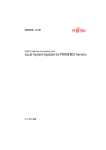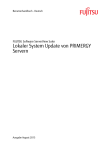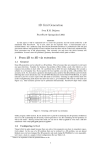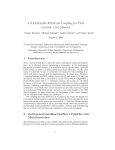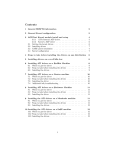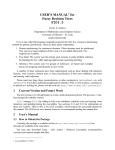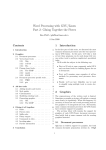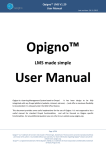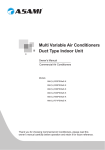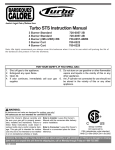Download Batch-oriented MPEG generation with GMV in background mode
Transcript
Batch-oriented MPEG generation with GMV in background mode Sven H.M. Buijssen, Stefan Turek Institute of Applied Mathematics, University of Heidelberg Im Neuenheimer Feld 294, 69120 Heidelberg, Germany Email: [email protected] Homepage: www.iwr.uni-heidelberg.de/featow June, 1999 Abstract For automatisation purposes we developed a perl-script called gmvmpeg that simplies the generation of MPEG movies with GMV, the General Mesh Viewer of the Los Alamos group. Particularly, the possibility to do this in background on (remote) computers might be of general interest. What it does There are numerous software packages for the visualization of numerical data. Within the FEATFLOW software, GMV (General Mesh Viewer) of Los Alamos National Laboratory belongs to our favourite tools. For an overview of the features of this program please see documentation. Mainly two features of GMV are exploited by the script gmvmpeg: GMV comes with the possibility to save an arbitrary conguration into an attribute le. Thus, all you need to do to generate an MPEG movie out of a sequence of les containing data from a numerical simulation is the following: (1) load a (more or less) arbitrary le from your sequence, (2) make a decision on the subset of data to be displayed and (3) save this conguration into a so-called attribute le. See also the other GMV reports at our homepage which describe the use of GMV for FEATFLOW data. Next, we can use the batch mode of GMV together with this attribute le to visualize all les of our sequence. The images we get are nally passed to an MPEG encoder to create a video. But there is one annoying peculiarity about the visualization process: for each le it processes GMV pops up a window on your screen and takes a screenshot of it. There is (at least for us) no way to tell GMV to do the visualization in background. Therefore, we avail ourselves in this program of a virtual framebu er X server called Xvfb. The output of GMV is side-tracked to this X server which emulates a dumb framebu er using virtual memory. Hence, we have no more windows popping up disturbing our work. In fact, the complete MPEG generation of one or several videos can be transferred to an arbitrary computer in a network. This means, you can even log in via modem and start this visualization process in a VT100 emulation. Installation and con guration The installation process is as simple as copying this script (which can be obtained from the FEATFLOW Homepage) to a directory you like. But you probably have to adjust a few variables within it. The script needs to know the location of the following programs: 1 for the visualization process can be downloaded from the GMV Homepage (see below). sgitopnm and ppmtoyuvsplit from the netpbm package for converting the GMV images into a format the MPEG encoder can handle Xvfb 1 (if you want to generate MPEG movies in background) which comes with the Xfree86 package which is distributed for free (see below). mpeg for the encoding process (see below). GMV Command line options has the following command line options to control the noninteractive generation of MPEG movies. They are partially explained in the GMV reports from our homepage, see also the references: attribute le: -a lename Path of the GMV attribute le to be used. gmvmpeg prex of input les: -i prex gmvmpeg assumes the following structure for the input les containing the data to be visualized: <prex>.<number>.gmv, where <number> is supposed to have no additional prex zeros. le name of MPEG movie (output): -o lename Basename of MPEG output (i.e. without the extension .mpeg) indices of input les: -s number1,number2,number3 The sequence of input les starts with number <number1> and ends with <number2> with a stride of <number3>. If <number3> is omitted or zero, time stepping is adaptive and all les available are taken. (s stands for rst,last,stride) These command line options are imperative. Optional are the following: invisible mode: -I, --invisible By default GMV will pop up a window for each le processed and make a snapshot of it. Due to the use of Xvfb you will not notice the generation process. gmvmpeg nds out the lowest available display number on the host concerning and starts Xvfb at that display. keep YUV frames: -k, --keep-les The snapshots are converted to YUV3 format and are, by default, deleted when the MPEG encoding has nished. If you want to play with di erent bitrates specify this option to avoid unnecessary regeneration. With the program mkmpeg mentioned in 2] you can then play around with di erent movie le sizes.2 maximum size of MPEG movie: -m number, --max number Tells the MPEG encoder to limit the le size to <number> MB. By default there is no limitation. 1 We successfully compiled Xvfb under SGI Irix 6.5 as well as under SunOS 5.5 and 5.6. However, we observed a latent instability: crashes when GMV has processed approximately a dozen input les. Therefore we have chosen to relaunch it for every input Xvfb le. 2 The program mkyuv which is also introduced in 2] is obsolete upon availability of gmvmpeg. 2 verbose: -V, --verbose Verbose mode. By default gmvmpeg will swallow all output from GMV and the MPEG encoder. version information: --version Prints version information. window size: -x number, -y number Resolution in x- and y-direction of the movie to be generated. Default values are 800x600. Where to get the programs mentioned (see also our homepage) gmvmpeg: http://www.iwr.uni-heidelberg.de/featflow/dl.html GMV: http://www-xdiv.lanl.gov/XCM/gmv/GMVHome.html NetPBM: http://wuarchive.wustl.edu/graphics/graphics/packages/NetPBM/ ImageMagick: http://www.wizards.dupont.com/cristy/ImageMagick.html Xvfb: http://www.xfree.org/ mpeg: http://www.mpeg.org/MPEG/video.html#video-software or at http://www.cselt.stet.it/mpeg/ visit the MPEG homepage For convenience reasons gmvmpeg autonomously determines the next free socket on a computer. This functionality was taken from the perl script vncserver, a wrapper script to start an X VNC server. This package (which is not needed for gmvmpeg) is published under the terms of the GNU General Public License and can be obtained from Virtual Network Computing (VNC): http://www.uk.research.att.com/vnc/index.html Example Finally, we want to show an invocation of gmvmpeg. We will give the same example as in 2] where we visualized a pressure distribution. Start GMV and adjust its settings for displaying a pressure distribution. Save your adjustments in an attribute le named pressure.attr. To create an MPEG movie called pressure.mpeg with a 400x320 resolution from the data les u.1.gmv to u.99.gmv, just type: gmvmpeg -a pressure.attr -i u -fls 1,99 -o pressure -x 400 -y 320 If you have prepared additional attribute les streamfunction.attr and temperature.attr, the batch oriented MPEG generation in invisible mode (i.e. with exploitation of Xvfb) can be started with the following shell script (only every second le is processed): 3 #!/bin/sh gmvmpeg -i u -fls 1,99,2 -x 400 -y 320 --invisible \ -a pressure.attr -o pressure gmvmpeg -i u -fls 1,99,2 -x 400 -y 320 --invisible \ -a streamfunction.attr -o streamfunction gmvmpeg -i u -fls 1,99,2 -x 400 -y 320 --invisible \ -a temperature.attr -o temperature # End sample.sh Program listing #!/usr/local/bin/perl # # by Sven H.M. Buijssen, 99/06/14 # # gmvmpeg - script to automate generation of mpeg movies with GMV. # use IO::Handle # # Location of programs needed # local $gmvGL ="/usr/local/bin/gmv" local $gmvMesa ="/usr/local/bin/gmv.mesa" local local local local # OpenGL version of gmv # Mesa version of gmv (used in # invisible mode (= use of Xvfb) $Xvfb ="/usr/local/bin/Xvfb" $sgitopnm ="/usr/freeware/bin/sgitopnm" $ppmtoyuvsplit="/usr/freeware/bin/ppmtoyuvsplit" $mpegEncoder ="/usr/local/bin/mpeg" # # Parameter for used programs # local $gmvToUse =$gmvGL # Typical Xvfb parameter on SGI (font path from /var/X11/xfs/config) # (Make sure that every path listed in the font path does really exist. # Otherwise Xvfb won't start.) local $XvfbParams ="-ac -terminate -fp \"". "/usr/lib/X11/fonts/100dpi/,/usr/lib/X11/fonts/75dpi/,". "/usr/lib/X11/fonts/misc/,/usr/lib/X11/fonts/Type1/,". "/usr/lib/X11/fonts/Speedo/\" ". "-sp /usr/lib/X11/xserver/SecurityPolicy ". "-screen 1 1028x768x32" # On Sun's we use following parameters #local $XvfbParams ="-ac -terminate -fp \"". # "/usr/openwin/lib/X11/fonts/misc,". 4 # # # # # # # "/usr/openwin/lib/X11/fonts/Speedo,". "/usr/openwin/lib/X11/fonts/Type1,". "/usr/openwin/lib/X11/fonts/100dpi,". "/usr/openwin/lib/X11/fonts/75dpi\" ". "-sp /usr/openwin/lib/X11/xserver/SecurityPolicy ". "-screen 1 1028x768x32 ". "-co /usr/openwin/lib/X11/rgb" # # Some default values # local $version="1.0.0" local $default_bitrate=5000000 (local $progname=$0) =~s/^.*\/(.*)/$1/ sub usage { print "Usage: $progname -a attribute_file] -fls first,last,stride] -i filename_prefix] -m size] -o output_filename] --verbose] -x xres] -y yres] --invisible] (*) -a : path for gmv attribute file to use (*) -fls : two or three comma separated digits that specify first and last index of gmv input file as well as the stride If stride is omitted or set to 0, time step is adaptive. -h, --help: this help screen (*) -i : prefix of gmv input files (followed by a dot and anumber without zero fills.) postfix \".gmv\" is assumed. e.g. u for u.2.gmv, u.3.gmv, u.4.gmv, ... -I, --invisible: use X server Xvfb for rendering process -k, --keep-files: don't delete temporary YUV frames -m, --max: maximum size of mpeg movie (in MB) (if omitted no limitation) (*) -o : name of output file (without extension .mpeg) -V, --verbose: verbose mode --version: print version information -x : resolution in x direction (if omitted set to 800) -y : resolution in y direction (if omitted set to 600) Arguments marked with (*) have to be specified. Example: $progname -a gmv_example.attr -o example -i u -fls 1,99,2 5 \n" } sub parseargv { local $ok=0 $xres=800 $yres=600 $attrfile="default.attr" $inbasename="u." $outfile="movie" $first=1 $last=1 $stride=1 $adaptive=0 $keepfiles=0 $maxmb=0 $verbose="> /dev/null" $useXvfb=0 for ($i=0 $i<=$#ARGV $i++) { $arg=$ARGV$i] if ($arg eq "-a") { $attrfile=$ARGV$i+1] $ok++ } elsif ($arg eq "-fls") { @list=split(/,/,$ARGV$i+1]) if ($#list<1 || $#list>3) { print "$progname: Syntax error in argument -fls, specifying\n". "first and last index as well as stride.\n\n". "Syntax has to be:\n first,last,stride\n\n" exit } $first=$list0] $last=$list1] if ($#list==2) { $stride=$list2] } else { $stride=0 } # adaptive time stepping if stride=0 if ($stride==0) { $adaptive=1 $stride=1 } $ok++ 6 } elsif ($arg eq "-help" || $arg eq "--help") { usage() exit } elsif ($arg eq "-i") { $inbasename=$ARGV$i+1] $ok++ } elsif ($arg eq "-I" || $arg eq "--invisible") { $useXvfb=1 $gmvToUse=$gmvMesa } elsif ($arg eq "-k" || $arg eq "--keep-files") { $keepfiles=1 } elsif ($arg eq "-m" || $arg eq "--max") { $maxmb=$ARGV$i+1] } elsif ($arg eq "-o") { $outfile=$ARGV$i+1] $ok++ } elsif ($arg eq "-V" || $arg eq "--verbose") { $verbose="" } elsif ($arg eq "--version") { print "$progname version $version\n" . "use '$progname -h' for a list of options\n" exit } elsif ($arg eq "-x") { $xres=$ARGV$i+1] } elsif ($arg eq "-y") { $yres=$ARGV$i+1] } } if ($ok<4) { usage() exit } } parseargv() STDOUT->autoflush(1) # # Check whether attrib file exists and is readable # if (! -r $attrfile) { print "$progname: Attribute file \"$attrfile\" does not exist or ". "is not readable.\nNothing done.\n" exit } if ($useXvfb == 1) { $originalDisplay = $ENV{DISPLAY} 7 &GetSocketConstants() $XvfbDisplayNumber = &GetDisplayNumber() ($XvfbDisplay = $originalDisplay) =~s/(^.*):.*/$1:$XvfbDisplayNumber.0/ $ENV{DISPLAY} = $XvfbDisplay } local $j=0 for ($i=$first $i<=$last $i+=$stride) { local $filename=$inbasename . "." . $i . ".gmv" # Process when file exists if (-r $filename) { $j++ # If specified start Xvfb if ($useXvfb == 1) { system("$Xvfb :$XvfbDisplayNumber $XvfbParams $verbose 2>/dev/null &") } print "*** Processing $filename... " print "\n$gmvToUse -m -a $attrfile -w 0 0 $xres $yres -i $filename ". "-s $verbose\n" if ($verbose eq "") system("$gmvToUse -m -a $attrfile -w 0 0 $xres $yres \\ -i $filename -s $verbose") if ($verbose eq "") { system("$sgitopnm AzsnapgmvAz | \\ $ppmtoyuvsplit $outfile$j $verbose") print "*** " } else { system("$sgitopnm AzsnapgmvAz 2>/dev/null | \\ $ppmtoyuvsplit $outfile$j $verbose") } print "done.\n" # If file does not exist and we don't have an adaptive time stepping # print error message and exit. } elsif (!$adaptive) { print "$progname: $filename: No such file or directory\n" exit } } # If at least one input file has been processed, generate a mpeg movie if ($j > 0) { # Reset DISPLAY environment variable $ENV{DISPLAY} = $originalDisplay if ($useXvfb == 1) 8 # Compute bitrate for mpeg encoder if ($maxmb <= 0) { $max_bits = $default_bitrate * $j / 25 } else { $max_bits = $maxmb * 1024 * 1024 * 8 } # Generate mpeg print "*** Generating movie $outfile.mpeg... " print "\n$mpegEncoder -PF -p 3 -a 1 -b $j -h $xres -v $yres ". "-x $max_bits -s $outfile.mpeg $outfile $verbose\n" if ($verbose eq "") system("$mpegEncoder -PF -p 3 -a 1 -b $j -h $xres -v $yres \\ -x $max_bits -s $outfile.mpeg $outfile $verbose") print "*** " if ($verbose eq "") print "done.\n" # Clean up working directory if ($keepfiles == 0) { print "*** Removing temporary files... " system("rm AzsnapgmvAz $verbose") system("rm $outfile*.Y") system("rm $outfile*.U") system("rm $outfile*.V") print "done.\n" } } else { print "$progname: No input files found. Nothing done.\n" } ###################################################################### # # Stuff taken from # vncserver - wrapper script to start an X VNC server. # # http://www.uk.research.att.com/vnc/index.html ###################################################################### # # # # # # # # Find socket constants. 'use Socket' is a perl5-ism, so we wrap it in an eval, and if it fails we try 'require "sys/socket.ph"'. If this fails, we just guess at the values. If you find perl moaning here, just hard-code the values of AF_INET and SOCK_STREAM. You can find these out for your platform by looking in /usr/include/sys/socket.h and related files. sub GetSocketConstants { chop($os = `uname`) 9 chop($osrev = `uname -r`) eval 'use Socket' if ($@) { eval 'require "sys/socket.ph"' if ($@) { if (($os eq "SunOS") && ($osrev !~ /^4/)) { $AF_INET = 2 $SOCK_STREAM = 2 } else { $AF_INET = 2 $SOCK_STREAM = 1 } } else { $AF_INET = &AF_INET $SOCK_STREAM = &SOCK_STREAM } } else { $AF_INET = &AF_INET $SOCK_STREAM = &SOCK_STREAM } } # # GetDisplayNumber gets the lowest available display number. # sub GetDisplayNumber { chop($host = `uname -n`) foreach $n (1..99) { if (&CheckDisplayNumber($n)) { return $n } } die "$prog: no free display number on $host.\n" } # # CheckDisplayNumber checks if the given display number is available. # sub CheckDisplayNumber { local ($n) = @_ socket(S, $AF_INET, $SOCK_STREAM, 0) || die "$prog: socket failed: $!\n" if (!bind(S, pack('S n x12', $AF_INET, 6000 + $n))) { 10 close(S) return 0 } close(S) socket(S, $AF_INET, $SOCK_STREAM, 0) || die "$prog: socket failed: $!\n" if (!bind(S, pack('S n x12', $AF_INET, 5900 + $n))) { close(S) return 0 } close(S) if (-e "/tmp/.X$n-lock") { warn "\nWarning: $host:$n is taken because of /tmp/.X$n-lock\n" warn "Remove this file if there is no X server $host:$n\n" return 0 } if (-e "/tmp/.X11-unix/X$n") { warn "\nWarning: $host:$n is taken because of /tmp/.X11-unix/X$n\n" warn "Remove this file if there is no X server $host:$n\n" return 0 } return 1 } exit # End of gmvmpeg References 1] Finite element software for the incompressible Navier-Stokes equations: User Manual, Release 1.1, 1998 (see also: http://www.iwr.uni-heidelberg.de/featflow/) 2] J.F. Acker, Working with GMV under FEATFLOW, Preprint 98 - 50 (SFB 359), October 1998 3] J.F. Acker, S. Turek, 3D Presentation of FEATFLOW Data with GMV, Preprint 99 - 19 (SFB 359), April 1999 All these papers are available at http://www.iwr.uni-heidelberg.de/featflow/dl.html. 11












